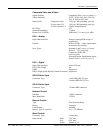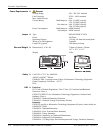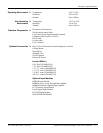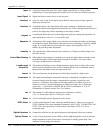
Appendix A: Glossary
Christie DS+60/DW30/Matrix 3000 User’s Manual A-5
PAL (Phase Alternating Line) video is a 50 Hz standard with 768 x 576 resolution. It
is found on some video tape and disk players (used primarily in Europe, China and
some South American and African countries).
The smallest discernible element of data from a computer-generated image.
The phase of the pixel sampling clock relative to incoming data.
The frequency of the pixel sampling clock, indicated by the number of pixels per line.
The projector is at presentation level when an image from a source is displayed
without the presence of a slidebar, menu, pull-down list, or error message.
The distance between the projector's front feet centers and the screen. Also called
"Throw Distance”.
The type of code format called “A” or “B” utilized by the IR remote keypad(s). The
default protocol set at manufacture is Protocol “A”. By using two different keypad
protocols, adjacent projectors can be controlled independently with their remote IR
keypads.
A selectable menu item that unfolds into a list of options pertaining to it.
A manufacturer of a digital video recorder/player/server, QuBit, frequently used for
providing digital cinema data. QuVis image compression uses a proprietary
technology called Quality Priority Encoding, based on wavelets, in which the user
selects a quality level based on signal-to-noise ratio. The data rate varies to efficiently
maintain that quality level. Frames are coded individually.
A translucent panel for screen projection. Incident light travels through the incident
surface of a rear screen and forms an image on the other surface.
The ability to manipulate through software commands the physical size, placement
and/or aspect ratio of an image.
The maximum number of alternate white and black horizontal lines that can be
distinguished on a screen when a photographic target is placed between the lens and a
light source and illuminated by that source.
The maximum number of pixels that the projector can display horizontally and
vertically across an image, such as 1024 x 768 (called XGA).
The time required by the video amplifier of the projector to increase its output from
10% to 90% of the maximum value.
The video output (analog or digital) of most computers. Analog RGB video can have
3, 4, or 5 wires — one each for red, green, and blue, and either none, one or two for
sync. For three-wire RGB, the green wire usually provides sync. (See TTL Video).
A common asynchronous data transmission standard recommended by the Electronics
Industries Association (EIA). Also called serial communication.
A less common asynchronous data transmission standard in which balanced
differential voltage is specified. RS-422 is especially suited to long distances.
PAL Video
f
Pixel
f
Pixel Phase
f
Pixel Trackin
g
f
Presentation Level
f
Projecto
r
-to-Screen f
Distance
Protocol
f
Pull-down List
f
QuVis
f
Rear Screen
f
Resizin
g
f
Resolution (lens)
f
Resolution (
p
ro
j
ector) f
Rise Time
f
RGB Video
f
RS-232
f
RS-422
f


















